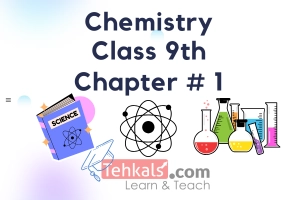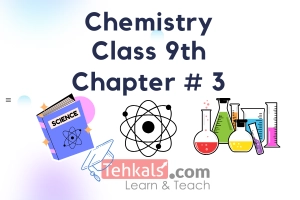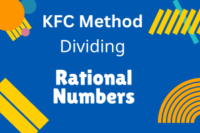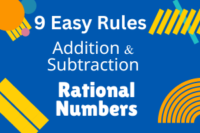Chemistry Class 9 Chapter 2
Published: 3 Sep 2023
Chemistry Class 9 Chapter 2 is about the “Structure of an Atom.” This article includes topics such as Rutherford’s Atomic Model, Neil Bohr’s Atomic Theory, Fundamental Particles of an atom like Electrons, Protons and Neutron, Electronic Configuration and Isotopes.
Chemistry Class 9 Chapter 2 Notes
Chemistry 9th Class Chapter 2
Structure of an Atom
Chemistry Class 9 Chapter 2-MCQs
Dalton Atomic Theory
1. A Greek philosopher “Democritus” suggested that all———— can be further divided into tiny particles.(a) matter
(b) substances
(c) elements
(d) All of them
Show Answer
All of them
2. The name of atom was given from the Greek word ————- which means indivisible.
(a) atomos
(b) atomics
(c) Halogens
(d) None of these
Show Answer
atoms
3. The word atom was first used —————.
(a) 400AD
(b) 400 BC
(c) 600AD
(d) 600BC
Show Answer
400 BC
4. No further work on atom was done until the ————– century.
(a) 18th
(b) 20th
(c) 19th
(d) 21st
Show Answer
19th
5. John Dalton, after a lot of experiments, concluded that all matter must be composed of tiny particles called —-.
(a) Atom
(b) Element
(c) isotope
(d) None of these
Show Answer
Atom
6. John Dalton states that an atom is ——————-.
(a) Invincible
(b) Indivisible
(c) Invisible
(d) None of these
Show Answer
Indivisible
7. John Dalton presented his own theory about atom in —————–.
(a) 1806
(b) 1906
(c) 1808
(d) 1908
Show Answer
1808
8. ————–is composed of very small particles called atoms.
(a) Matter
(b) Energy
(c) Numbers
(d) All of these
Show Answer
Matter
9. Atom can neither be created nor ———————.
(a) Formulated
(b) Destroyed
(c) combined
(d) None of these
Show Answer
Destroyed
10. Atoms combine with each other in ————– number ratio.
(a) Integers
(b) Quadratic
(c) Whole
(d) None of these
Show Answer
Whole
11. Atoms of particular element are ———— in size shape, mass and also in other properties.
(a) Different
(b) Identical
(c) Atomic
(d) None of these
Show Answer
Identical
12. All chemical reactions occur due to the combination or ————— of atoms.
(a) Separation
(b) Distillation
(c) Filtration
(d) None
Show Answer
Separation
Rutherford’s Atomic Model
Rutherford’s Experiment
Main Points of Rutherford’s Atomic Model
Drawbacks of Rutherford’s Atomic Model
13. In———-, Rutherford performed an experiment to know the arrangement of electron and protons in an atom.(a) 1910
(b) 1912
(c) 1911
(d) 1913
Show Answer
1911
14. In Rutherford experiment which part of the atom has been discovered?
(a) Energy levels
(b) Nucleus
(c) Other
(d) None
Show Answer
Nucleus
15. ————— performed an experiment to determine the internal structure of the atom in 1911.
(a) J.J Thompson
(b) Max plank
(c) Rutherford
(d) None of these
Show Answer
Rutherford
16. In Rutherford experiment, what he has used?
(a) Gold foil
(b) Gold bar
(c) Silver foil
(d) Tin plates
Show Answer
Gold foil
17. He bombarded the ________ particles on gold foil from a radioactive source.
(a) Beta
(b) Alpha
(c) Gamma
(d) None of these
Show Answer
Alpha
18. What radioactive source does Rutherford used?
(a) Polonium
(b) Thorium
(c) Radon
(d) None of these
Show Answer
Polonium
19. This experiment showed that most of the volume occupied by the atom is —————.
(a) Bulky
(b) Small
(c) Empty
(d) None of these
Show Answer
Empty
20. From this experiment, Rutherford concluded that an atom contains a ———– portion i.e. nucleus.
(a) Negative
(b) Positive
(c) Neutral
(d) None of these
Show Answer
Positive
21. Similar charges ————–each other.
(a) Repel
(b) Attract
(c) Articulate
(d) All of these
Show Answer
Repel
22. On the basis of his conclusion drawn from the experiment, Rutherford proposed a new model at atom called ————-model.
(a) Planetary
(b) Universal
(c) Room & Cat
(d) None of these
Show Answer
Planetary
23. Atom consists of positively charged nucleus which contains ———and neutrons.
(a) Electrons
(b) Protons
(c) Fundamental particles
(d) None of these
Show Answer
Protons
24. Electrons are ————around the nucleus just like the planets around the sun.
(a) Stand still
(b) Gathered
(c) Revolving
(d) None of these
Show Answer
Revolving
25. The electrons around the nucleus would require ————- force.
(a) Centripetal
(b) Centrifugal
(c) Net
(d) Average
Show Answer
Centripetal
26. The size of the ————- is very small as compared to the size of atom.
(a) proton
(b) Neutron
(c) Nucleus
(d) All of them
Show Answer
All of them
27. Atom is ———— because electrons and protons will cancel the effect of each other.
(a) Negatively charge
(b) Neutral
(c) Positively charged
(d) None of these
Show Answer
Neutral
28. Rutherford atomic model of an atom resembles our ________ system.
(a) Solar
(b) Universal
(c) Gravitational
(d) None of these
Show Answer
Solar
29. Rutherford model is applicable to neutral bodies and not on ————.
(a) Isotopes
(b) Energy
(c) Charged bodies
(d) None of these
Show Answer
Charged bodies
30. According to which scientist, electrons are charged bodies revolving around the nucleus and emit energy.
(a) Rutherford
(b) Schrodinger
(c) Maxwell
(d) None of these
Show Answer
Maxwell
31. If electrons radiate energy continuously then the ———–spectrum will be obtained.
(a) Line
(b) Continuous
(c) Both
(d) None of these
Show Answer
Continuous
32. Rutherford atomic model does not provide any explanation about ———— properties of elements.
(a) Chemical
(b) Physical
(c) Elemental
(d) None of these
Show Answer
Chemical
Neil Bohr’s Atomic Theory
33. In ————-, Neil Bohr proposed a new atomic theory to overcome the defects of Rutherford atomic model.(a) 1901
(b) 1910
(c) 1915
(d) 1913
Show Answer
1913
34. Bohr considered ———-atom as a model.
(a) Helium
(b) Hydrogen
(c) Thorium
(d) None of these
Show Answer
Hydrogen
35. Electrons are revolving around the fixed circular path called ————-.
(a) Shells
(b) Orbits
(c) cycles
(d) Both a and b
Show Answer
Both a and b
36. Each shell has a —————– energy.
(a) Fixed
(b) variable
(c) No
(d) None of these
Show Answer
Fixed
37. The farther the electron from the nucleus, the ———— will be the energy and vice versa.
(a) Lower
(b) Higher
(c) Intermediate
(d) None of these
Show Answer
Higher
38. The ________ of an object is fixed.
(a) Frequency
(b) Volume
(c) Energy
(d) None of these
Show Answer
Energy
39. $ ∆E=E_2-E_1=h \mu $ In ths equation what is “h”?
(a) Plank’s constant
(b) Max constant
(c) Variable
(d) None of these
Show Answer
Plank’s constant
40 Electrons can’t stay in ———shells.
(a) 1st
(b) 2nd
(c) Between
(d) None of these
Show Answer
Between
To Download Complete Notes of Class 9 Chemistry Notes, Click the link.
Fundamental Particles of an atom
Electron
Proton
Neutron
41. Modern research show that an atom consist of ————— subatomic particles.(a) 13
(b) 03
(c) 05
(d) None of these
Show Answer
03
42. Election is ————— charged particle.
(a) Negatively
(b) Positively
(c) Neutral
(d) All of these
Show Answer
Negatively
43. Mass of electron is ————–.
(a) $ 9.11 \times 10^{31} kg $
(b) $ 9.11 \times 10^{-31} kg $
(c) $ 6.023 \times 10^{23} kg $
(d) All of these
Show Answer
$ 9.11 \times 10^{-31} kg $
44. Proton is a ———— charged particle.
(a) Negatively
(b) Positively
(c) Neutral
(d) None of these
Show Answer
Positively
45. Mass of proton is —————.
(a) $ 1.6726 \times 10^{-27} \ kg $
(b) $ 9.11 \times 10^{-31} \ kg $
(c) $ 1.37 \times 10^6 \ kg $
(d) All of these
Show Answer
$ 1.6726 \times 10^{-27} \ kg $
46. Proton is ———– times heavier than electron.
(a) 1847
(b) 1827
(c) 1837
(d) All of these
Show Answer
1837
47. Neutron is a ————- particle because it has no charge.
(a) Negative
(b) Positive
(c) Neutral
(d) None of these
Show Answer
Neutral
48. Neutron is ———– times Havier than proton.
(a) 05
(b) 15
(c) 50
(d) 150
Show Answer
05
Electronic Configuration
Energy Level
s and p Sub-Shell
Shell (Orbit)
Sub-Shell
49. The ———— of electrons around the nucleus in shells is called electronic configuration.(a) Separation
(b) Distribution
(c) Catenation
(d) None of these
Show Answer
Distribution
50. These shells are represented by ————.
(a) Alphabets
(b) Numeric
(c) Romans
(d) None of these
Show Answer
Alphabets
51. The maximum number of electrons in a particular shell is given by the formula ————.
(a) $ 4n^2 $
(b) $ 2n^3 $
(c) $ 4n^3 $
(d) $ 2n^2 $
Show Answer
$ 2n^2 $
52. How many electrons are there K-shell?
(a) 2
(b) 8
(c) 18
(d) 32
Show Answer
2
53. How many electrons are there in L-shell?
(a) 2
(b) 8
(c) 18
(d) 32
Show Answer
8
54. How many electrons are there in M-shell?
(a) 2
(b) 8
(c) 18
(d) 32
Show Answer
18
55. How many electrons are there in N-shell?
(a) 2
(b) 8
(c) 18
(d) 32
Show Answer
32
56. A shell or orbit is also is also called ———–.
(a) Energy level
(b) Hertz
(c) Atomic mass
(d) None of these
Show Answer
Energy level
57. How many sub-shall are there in a shell?
(a) 14
(b) 10
(c) 04
(d) None of these
Show Answer
04
58. Which of them are sub-shell?
(a) s, p, d, f
(b) x, y, z
(c) K, L, M, N
(d) None of these
Show Answer
s, p, d, f
59. “s” sub –shell stands for ————-.
(a) Specific
(b) Sharp
(c) Sonic
(d) All of these
Show Answer
Sharp
60 “p” sub-shell stands for —————
(a) Principal
(b) principle
(c) Para-magnetic
(d) None of these
Show Answer
Principal
61 “d” sub –shell stands for ————-.
(a) Drainage
(b) dissolved
(c) diffused
(d) All of these
Show Answer
diffused
62. “f” sub-shell stand for———–.
(a) Fermium
(b) fundamental
(c) Fencing
(d) None of these
Show Answer
fundamental
63. “f” sub-shell can accommodate————- electrons.
(a) 2
(b) 6
(c) 10
(d) 14
Show Answer
14
64. Complete the electronic configuration of carbon atom i.e. $ 1s^2, 2S^2, $ ————-.
(a) $ 2p^2 $
(b) $ 2p^3 $
(c) $ 2p^4 $
(d) $ 2p^5 $
Show Answer
$ 2p^2 $
Isotopes
65. Atoms of the same element having same atomic number but different ———– is called isotopes.(a) Density
(b) Mobility
(c) Mass number
(d) None of these
Show Answer
Mass number
66. Atoms having same number of protons and electrons but differ number of neutrons are called ———–.
(a) Metallurgy
(b) Isotopes
(c) Surface area
(d) None of these
Show Answer
Isotopes
Isotopes of Hydrogen
67. How many isotopes hydrogen has?(a) 03
(b) 06
(c) 09
(d) 12
Show Answer
03
68. Protium, deuterium and tritium are the isotopes of ————-.
(a) carbon
(b) chlorine
(c) Hydrogen
(d) None of these
Show Answer
Hydrogen
69. What is the most abundant isotope of hydrogen?
(a) Protium
(b) Deuterium
(c) tritium
(d) None of these
Show Answer
Protium
70. Which isotope of hydrogen is rarely found in nature?
(a) Protium
(b) Deuterium
(c) Tritium
(d) None of these
Show Answer
Tritium
71. How many neutrons are there in tritium?
(a) 02
(b) 03
(c) 01
(d) None of these
Show Answer
02
Isotopes of Carbon
72. Atomic number of carbon is ————-.(a) 07
(b) 06
(c) 08
(d) None of these
Show Answer
06
73. Carbon is the first member of ————–.
(a) Group 1
(b) Group 7
(c) Group 4
(d) Group 6
Show Answer
Group 4
74. How many isotopes of carbon are there in nature?
(a) 03
(b) 13
(c) 07
(d) 14
Show Answer
03
75. $ C -12, C -13 \ and \ C -14 $ are the isotopes of ————–.
(a) Iodine
(b) Radon
(c) Carbon
(d) none
Show Answer
carbon
76. Number of neutrons in $ Carbon-14 \ \left(_{14}C^6 \right) $ is —————.
(a) 7
(b) 8
(c) 9
(d) 10
Show Answer
8
Isotopes of Chlorine
77. Atomic number of chlorine is ——————–.(a) 17
(b) 6
(c) 1
(d) 3
Show Answer
17
78. Chlorine is the second member of ————-
(a) Group 1
(b) Group 4
(c) Group 7
(d) Group 5
Show Answer
Group 7
79. Group 7is also called ————-
(a) Alkali metals
(b) Halogens
(c) Nobles
(d) none
Show Answer
Halogens
80. How many isotopes of chlorines are there in nature?
(a) 02
(b) 12
(c) 03
(d) 13
Show Answer
02
81. $ Cl -35 \ and \ Cl-37 $ are isotopes of ————–.
(a) Radon
(b) Krypton
(c) Chlorine
(d) Hydrogen
Show Answer
Chlorine
82. The abundance of $ Cl -35 $ is —————-.
(a) 75.53 %
(b) 53.75 %
(c) 73.55 %
(d) 53. 66 %
Show Answer
75.53 %
83. The abundance of $ Cl-37 $ is————- in nature.
(a) 24.47 %
(b) 47.24 %
(c) 74. 42 %
(d) 54.26 %
Show Answer
24.47 %
84. The number of neutrons in $ Cl-35 $ is 18 and $ Cl-37 $ is —————-.
(a) 20
(b) 40
(c) 02
(d) 04
Show Answer
20
Isotopes of Uranium
85. Atomic number of uranium is —————.(a) 82
(b) 92
(c) 28
(d) 29
Show Answer
92
86. How many isotopes of uranium in nature?
(a) 07
(b) 05
(c) 03
(d) 04
Show Answer
03
87. The most abundant isotope of uranium is —————.
(a) $ U -238 $
(b) $ U-235 $
(c) $ U-234 $
(d) $ U-236 $
Show Answer
$ U -238 $
88. The neutrons quantity in U-238 is ————–.
(a) 142
(b) 146
(c) 143
(d) 145
Show Answer
146
Uses of Isotopes
89. $ Iodine -131 $ is used for the cure of ————-.(a) Pneumonia
(b) Cancer
(c) Goiter
(d) None of these
Show Answer
Goiter
90. $ Cobalt -60 $ is used for the treatment of —————-.
(a) Cancer
(b) Diarrhea
(c) Tumor
(d) Treat less
Show Answer
Cancer
91. $ Carbon -14 $ is used to trace the path of carbon in ————–.
(a) Respiration
(b) Photosynthesis
(c) Reduction
(d) None of these
Show Answer
Photosynthesis
92. $ Californium -252 $ is used to inspect airplane luggage for hidden —————-.
(a) Explosives
(b) Smoke detectors
(c) Carbon tracing
(d) None of these
Show Answer
Explosives
Review Exercise Chapter 2
93. The maximum number of electrons in third energy level is:(a) 10
(b) 32
(c) 18
(d) 64
Show Answer
18
94. Mass of an atom is mostly due to its
(a) Nucleus
(b) Neutrons
(c) Electrons
(d) Protons
Show Answer
Nucleus
95. If Rutherford had used neutrons instead of alpha particles in his scattering experiment, the neutrons would
(a) Not deflect because they have no charge
(b) Have deflected more often
(c) Have been attracted to the nucleus easily
(d) Have given the same results
Show Answer
Not deflect because they have no charge
96. Electron in its ground state does not
(a) Spin
(b) Revolve
(c) Radiate energy
(d) Reside in orbit
Show Answer
Radiate energy
97. Which statement about $ _6^{12}X \ and \ _6^{14}Y $ is false except
(a) They are isotopes
(b) They are the same elements
(c) They have the same number of electrons
(d) They have the same number of neutrons
Show Answer
They have the same number of electrons
98. The neutron particle
(a) Has a mass equal to that of an electron
(b) Has a mass approximately equal to that of a proton
(c) Has charge equal to but opposite to that of an electron
(d) Has a positive charge
Show Answer
Has a mass approximately equal to that of a proton
99. Isotopes of the same element have
(a) The same number of protons
(b) The same number of neutrons
(c) Different number of electrons
(d) The same mass number
Show Answer
The same number of protons
100. Which one is the lightest?
(a) An alpha particle
(b) A hydrogen atom
(c) An electron
(d) A proton
Show Answer
An electron
101. The nucleus of an atom has all of the following Characteristics except that
(a) Is positively charged
(b) Is very dense
(c) Contains nearly all of the atom’s mass
(d) Contains nearly all of the atom’s volume
Show Answer
Contains nearly all of the atom’s volume
102. L – shell has sub – shell (s)
(a) s
(b) s and p
(c) s, p, and d
(d) s, p, d and f
Show Answer
s and p






Very easy mcqs